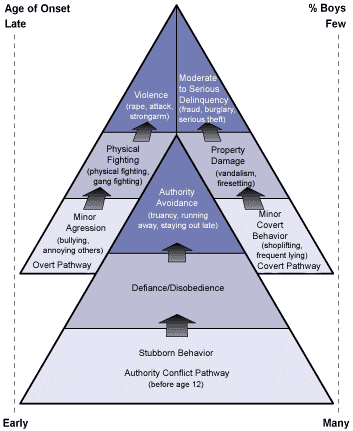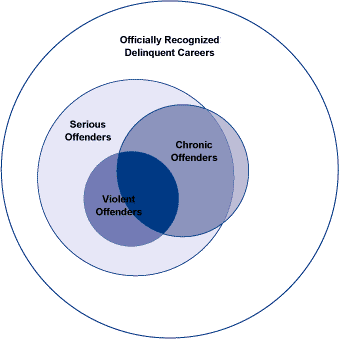|
SVJ Offenders -- A Distinct Group The first major conclusion the Study Group drew was that the SVJ offender is substantially different from the typical juvenile involved in delinquent conduct. The majority of SVJ offenders are male and usually display early minor behavior problems that lead to more serious delinquent acts. Figure 1 shows three pathways that can help to explain males' progression to SVJ offending: the authority conflict pathway (before age 12), the overt pathway, and the covert pathway. Those who reach the last step in each pathway usually have gone through the preceding steps. When these youth begin to commit more serious delinquent acts, they typically also continue to commit less serious delinquent acts. Youth who become SVJ offenders tend to escalate to serious and violent offending either via the authority conflict pathway and the covert pathway (property offenders) or via the authority conflict pathway, the covert pathway, and the overt pathway (violent and property offenders). The majority of SVJ offenders also tend to have multiple problems such as substance abuse and mental health difficulties in addition to truancy, suspension, expulsion, and dropping out of school. Furthermore, SVJ offenders are disproportionately victims of violence.
Figure 1: Pathways to Boys' Disruptive
An analysis of how early SVJ offending begins revealed that the actual delinquency careers of SVJ offenders are quite different from what is officially recorded. Table 1 shows that, on average, the first contact with the juvenile court for male Crime Index offenders was at age 14.5. The actual delinquency careers of these offenders (judging from their own statements and those of their mothers) started much earlier. Viewed in relation to the pathway model (figure 1), youth who were brought to court for Index offenses at age 14.5 typically began to have minor behavior problems at age 7.0, progressed to moderately serious behavior problems at age 9.5, and committed serious delinquent offenses at age 11.9. Thus, on average, more than 7 years elapsed between the earliest minor problem behaviors and the first court appearance for a Crime Index offense.Behavior and Delinquency
Figure 2: Officially Recognized Delinquent Careers: Overlap of Serious, Violent, and Chronic Offender Careers
| ||||||||||||||||



